Best Budget 4k Tv for Xbox One X
Best Budget 4k Tv for Xbox One X
All-time gaming TVs for PS5 and Xbox Series X (and all other consoles)
Best gaming TVs Buying Guide: Welcome to What Howdy-Fi?'s round-up of the all-time gaming TVs y'all can buy in 2022.
If you desire to amp upwardly your favourite video game, it's worth splashing out on a bigger, brighter telly, and one with deeper blacks that will immerse yous in the activity.
Earlier we become into our full listing of the best gaming TVs, it's worth going over what makes a great gaming Television and explaining what the acronyms you'll encounter in the spec lists actually mean. That said, if you already know all of that stuff (or simply don't care) click here to get straight to the best gaming TVs y'all tin purchase.
- Best PS5 deals: where to buy a PS5
- Best Xbox Series Ten deals: where to buy the new Xbox
- Best gaming headsets
How to choose the best gaming Tv set for you
There'southward a huge corporeality to consider when choosing a gaming TV, to the extent that you lot'll find a very long explainer at the bottom of this page (to bound straight to that, click here), but here'due south a slightly more condensed version.
The nigh crucial factors at play are which console you play games on and to what extent you want to take advantage of its most advanced features.
(If you're unsure what the acronyms below mean, click the links or scroll to the bottom of the page for more information)
The Xbox Series X (and, to an extent, its sibling the Series South) is the nearly advanced of the consoles, thank you to its support for 4K/120Hz gaming, Dolby Vision gaming, VRR, ALLM and HGiG. A Tv set that supports only some or none of these tin still be great for gaming, but if you lot want to be at the bleeding border of gaming tech, these are the specs to look for in a gaming TV. 4K/120Hz tin even give you a competitive advantage in games that support it.
The PS5 too supports 4K/120Hz gaming, ALLM and HGiG. Dolby Vision gaming isn't supported and there'due south no indication that information technology volition exist added, and then you don't need to worry about that. VRR is due to be added to the console in the nigh future, though, and then you may want to expect for a TV that too supports that.
With gaming PCs things are much more complicated. Many of the technologies mentioned higher up are supported by some graphics cards just you too have even college refresh rates, custom resolutions and ultra-widescreen ratios to consider, which is why many PC gamers prefer monitors to TVs. This guide is primarily aimed at console gamers.
If you're using an older panel or a Nintendo Switch, almost any modernistic 4K HDR TV will have the specs to make it sing (though the Xbox Ane Ten and One South do support VRR, which is less common), but with all consoles you should exist looking for a Goggle box with depression input lag, which dictates how long it takes for your button presses to be reflected on-screen.
Finally simply very chiefly, you also want a Boob tube with excellent core pic quality: abrupt, bright, with excellent blacks and vibrant, accurate colours. Arguably, those elements are more than important than the specs mentioned above, which should really exist considered the icing on the cake.
The best gaming TVs yous tin can buy
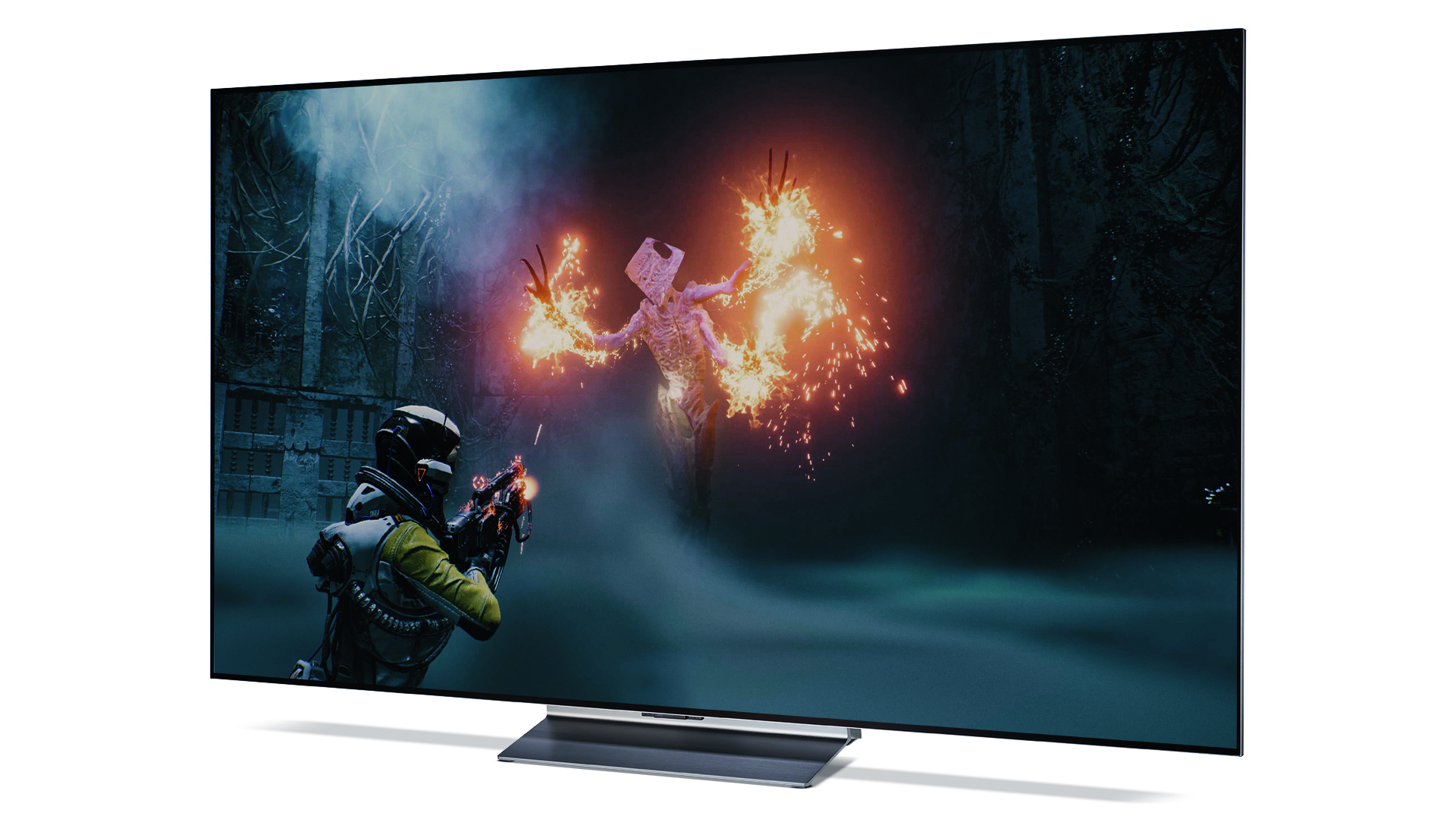
LG's OLEDs accept been the become-go choice for gamers for a few years at present (its authorization of this list is no accident), and the new G2 is merely the best yet.
The big news is that this is the brightest OLED that LG has always produced, thanks to a combination of OLED Evo technology and a new heat sink element that allows the panel to be driven even harder than before. The extra punch is transformative, making all content (including games) popular from the screen in glorious fashion. Thankfully, blackness depth hasn't been sacrificed, so overall contrast is amazing, and in fact in that location's been an uptick in shadow detail, which not only makes the motion-picture show more authentic, it also makes for fewer surprises in online deathmatches.
The overall gaming spec is unbeatable, too. LG'due south TVs are unique in supporting Dolby Vision gaming right up to 120Hz, while all iv of its HDMI inputs are rated to the maximum 48Gbps and back up 4K/120Hz, VRR and ALLM. There's as well an effective HGiG setting for more accurate HDR tone mapping, and we measured input lag at a lightning-fast ix.4ms.
The only downsides to the G2 are its premium price, lack of a bundled stand (it'south primarily designed to be wall-mounted) and that information technology'southward not available in sizes below 55 inches (we tested the 65-inch version). If those are major obstacles for y'all, wait out for our imminent review of the C2, which is less brilliant than the G2 but solves all of those slight issues.
Read the total LG OLED65G2 review
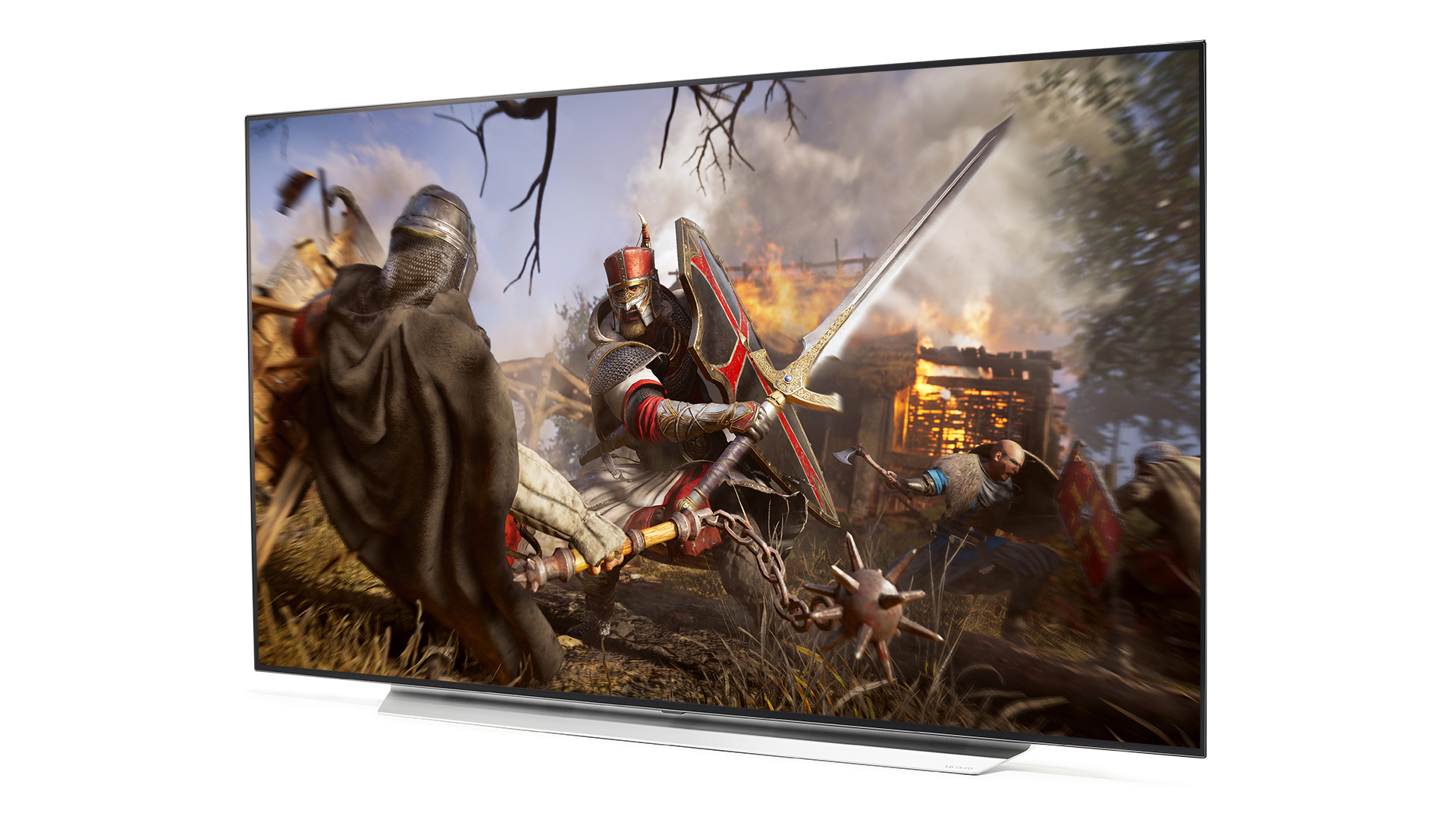
If you're looking for a much more than affordable and much more than compact LG OLED, the 48-inch version of 2021'south C1 is the way to become.
Like the G2 in a higher place, it boasts four HDMI ii.ane sockets with support for eARC, 4K/120hz, ALLM (Automobile Low Latency Manner) and VRR (Variable Refresh Rate). VRR is supported in all three current formats, the virtually of import HDMI VRR format, Nvidia K-Sync and AMD Freesync Premium. HGiG and Dolby Vision gaming are supported, also, and while its HDMI 2.1 sockets are 'merely' rated to 40Gbps, no current panel demands more than that anyhow.
The dedicated Game Optimiser menu gives y'all quick access to all of those game-related settings every bit well every bit features that adjust gaming picture functioning, either based on the genre of the game you're playing or through manual tweaking of the detail in the brightest and darkest parts of the movie.
In curt, simply the newer C2 and G2 are better-specified gaming TVs, and even then it's not by much, so the C1 is well worth picking up while it'due south discounted and before stock runs out.
Nosotros've tested the C1 in its 48-inch and 65-inch sizes, and yous can read full reviews of both TVs by clicking the links below.
Read the full LG OLED48C1 review
Read the total LG OLED65C1 review
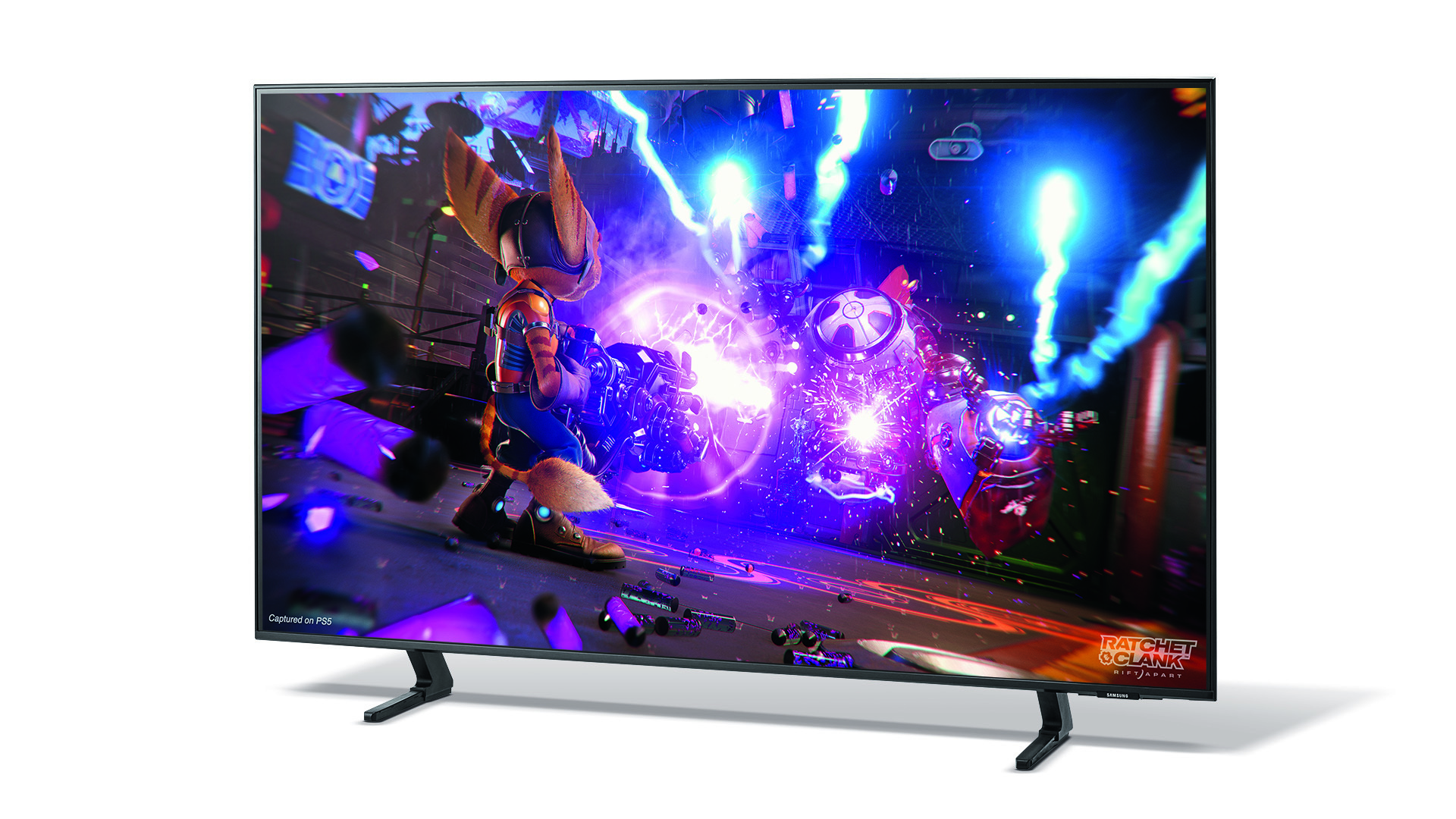
While it's non upward there with the OLEDs and QLEDs on this list, Samsung's AU9000 LCD model is a great choice for gamers on a budget.
Unlike the cheaper AU models, the AU9000's three HDMIs support both VRR and 120Hz signals. This instantly makes the UE50AU9000 a much more compelling option every bit a monitor for a PS5, Xbox Series X or a PC with a new loftier-cease Nvidia or AMD graphics card – even though the 120Hz back up can simply exist sustained at 1080p resolutions rather than 4K.
The gaming features don't end in that location, either. At that place's likewise support for ALLM, and input lag with Game manner activated is a minuscule 9.2ms. You can think a handy Game Bar display that shows yous at a glance what graphics features a game is using.
What'southward more, in keeping with Samsung's Neo QLED TVs, the 50AU9000 can back up playback in 32:9 ratio from PC games that support this super-wide format.
Its effulgence and rich but controlled colours play beautifully with the spectacular 4K HDR graphics capabilities of the latest gaming machines, while the support for higher and variable refresh rates joins forces with the uncommonly low input lag to contribute to a fantastically immediate and immersive experience. Deeper blacks would be squeamish, though.
Read the full Samsung UE50AU9000 review
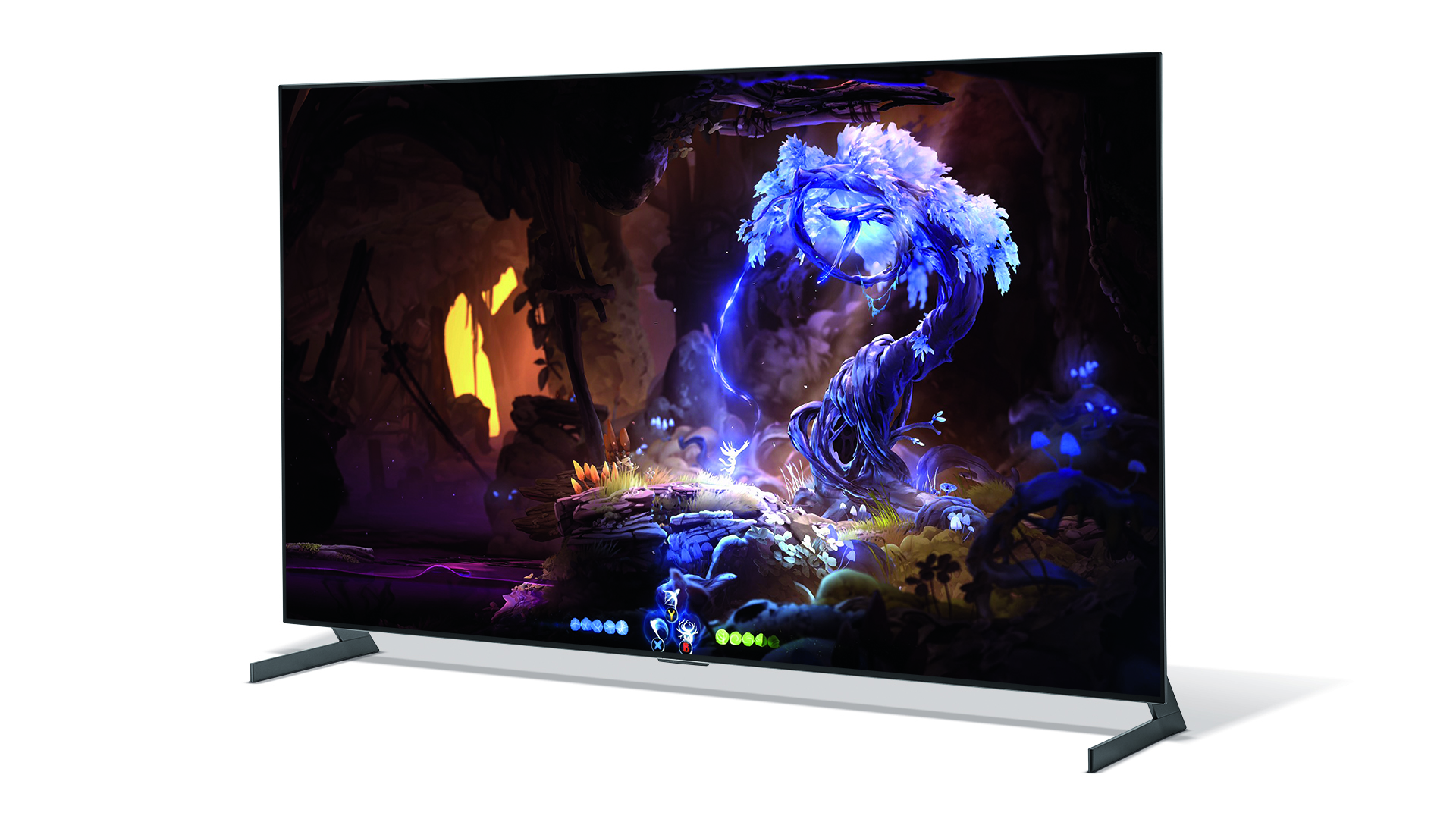
LG'south first 'OLED Evo' TV, 2021's G1 is withal an excellent buy even though it'southward at present been slightly overshadowed by the new G2 (and, to a lesser extent, the C2).
So, it's not as bright equally the new G2, but it'south still very bright by OLED standards, non to mention terrifically sharp and detailed.
It'south also got all of the gaming features we've come to expect from LG OLEDs: iv 40gbps HDMI 2.1 sockets with support for 4K@120Hz, VRR and ALLM (plus eARC); an HGiG mode for more accurate dissimilarity with HDR games; a sub-13ms input lag; and a Game Optimiser menu that allows for more game-related fine-tuning and puts all options at your fingertips.
Sound is less strong, but if yous were ever planning to combine your new Television receiver with a carve up sound system and the wall-mountain design works for you (a tabletop stand is an optional extra), the G1 should exist seriously considered while it's discounted and still bachelor.
Read the total LG OLED65G1 review

2021 was very much the year of Mini LED, and Samsung went bigger on this new backlighting technology than anyone else.
The company has developed its own Mini LEDs, which are just 1-fortieth the size of traditional backlight LEDs, and combined them with its existing Quantum Dot tech to create a range of premium TVs that it calls Neo QLEDs. The QE65QN95A is the first Neo QLED we tested, and Samsung's current flagship 4K prepare – at to the lowest degree until the new QN95B hits shops.
In real-globe performance terms, Mini LED might non quite be the revolution that Samsung is pitching it as, but it is still a substantial upgrade to an already excellent range of TVs. The overall dissimilarity offered is staggering, and the QN95A combines near-OLED black levels with awesomely crisp white highlights and fabulously vibrant colours, all while retaining an effortless sense of naturalism.
On the gaming front, all four of the QN95A'south HDMIs support ALLM, 4K@120Hz and VRR (Variable Refresh Rate). And VRR is supported in all three of the formats currently bachelor: standard HDMI VRR, Nvidia Grand-Sync and AMD FreeSync (this was the kickoff Tv set to exist FreeSync Premium Pro-certified, in fact).
Samsung's as well created the 'Game Bar' – a popular-up carte that gives you lot quick access to various game-related features and delivers live information on the point being received, including the VRR format and frame rate. Input lag, meanwhile, has been reduced to nether 10ms, which is entirely imperceptible. If you don't heed sacrificing a little of that speed, you can enable some gaming-specific movement smoothing, although we don't notice that necessary during testing.
Finally, on the gaming front end, the HGiG (HDR Gaming Interest Group) setting that was added to Samsung's 2020 QLEDs via a software update late last year is also nowadays on the QN95A. This is well worth using in conjunction with your console'south HDR calibration settings as it results in a more authentic picture with deeper blacks and more detailed highlights.
All told, games absolutely pop when played on the QN95A, and performance is lightning-fast and super-slick. Throw in the all-time, most app-packed operating system in the business and this is (a lack of Dolby Vision support bated) equally consummate a package every bit can be imagined.
And if you can live with just one HDMI 2.1 socket, check out our review of the QE65QN94A, which lacks the QN95A's One Connect box only otherwise boasts the same feature set and performance.
Read the total Samsung QE65QN95A review
Read the full Samsung QE65QN94A review

While Philips' 2020 OLEDs were brilliant for movies and Tv set, they were sadly lacking next-gen gaming features. That'south non the case with 2021's OLED806, which has two total-fat 48Gbps HDMI two.1 sockets that support 4K@120Hz, VRR in all of its current forms, and ALLM, making this a very well-specified gaming TV. The very low input lag of effectually 14ms certainly helps matters, besides, as does the HGiG mode, which broadly results in more than authentic tone mapping of HDR games.
The only gaming spec of notation that's missing is support for 4K@120Hz with Dolby Vision, simply Dolby Vision gaming is at least supported up to 60Hz.
One other matter to bear in mind is that 1 of the ii HDMI 2.1 sockets is too the 1 that handles eARC, which ways that if you have two HDMI 2.1 sources (an Xbox Series 10 and PS5 or a loftier-end gaming PC), you're not besides going to be able to ship sound via eARC to a soundbar or AV amplifier. This is a limitation of all TVs that we've tested that have ii HDMI 2.one sockets and, different those others, Philips does somewhat mitigate the consequence by supporting standard ARC via its other 3 HDMI sockets. This won't become y'all lossless, TrueHD Dolby Atmos, but it will get you lot Atmos in the Dolby Digital+ format, and we doubt that many volition hear much of a difference.
In terms of the overall performance, the OLED806 is a stunner. Sharper and punchier than rival OLEDs, with a vibrant arroyo that suits games without over-cooking them. Sound is proficient by Idiot box standards, besides, and the gorgeous Ambilight technology adds an extra dose of the spectacular to everything you play and watch.
We've tested the OLED806 in its 48-inch and 65-inch sizes. You tin read both reviews past clicking below.
Read the full Philips 48OLED806 review
Read the full Philips 65OLED806 review

Just because a Television is minor by today'southward increasingly expansive standards doesn't mean it has to be boring. The l-inch Samsung QE50QN90A is a case in point: hither we have a relatively diminutive screen that throws everything just the proverbial kitchen sink at delivering a premium picture and sound performance to rival the all-time that its much bigger brethren accept to offer.
For starters, this is a Neo QLED model, which means it combines Breakthrough Dots with a Mini LED backlight. This results in a supremely brilliant and vibrant motion-picture show with truly excellent contrast – that's a particularly tasty combination for gaming. While but one of the HDMIs is ii.1-certified (LG'southward 48-inch C1 has iv HDMI 2.1 sockets), information technology does support all of the key gaming technologies, including 4K/120Hz, VRR and ALLM, and there's an HGiG mode for more accurate HDR tone mapping. At that place's no Dolby Vision gaming, of form, as Samsung TVs don't back up Dolby Vision in any form.
Images look exceptionally detailed and crisp with both video and gaming sources, fully selling the screen's native 4K resolution despite the relatively small 50-inch screen size, and the audio is good, also, with skilful dial and weight.
This is a great purchase if you want a premium gaming feel at a smaller size, but do also check out the LG OLED48C1 above.
Those looking for a larger screen might be interested to read that the QN90A is bachelor in a wide diverseness of sizes, but be aware that these all appear to use a different panel type (IPS rather than the 50-inch model'southward VA), and so functioning may well vary.
Read the total Samsung QE50QN90A review
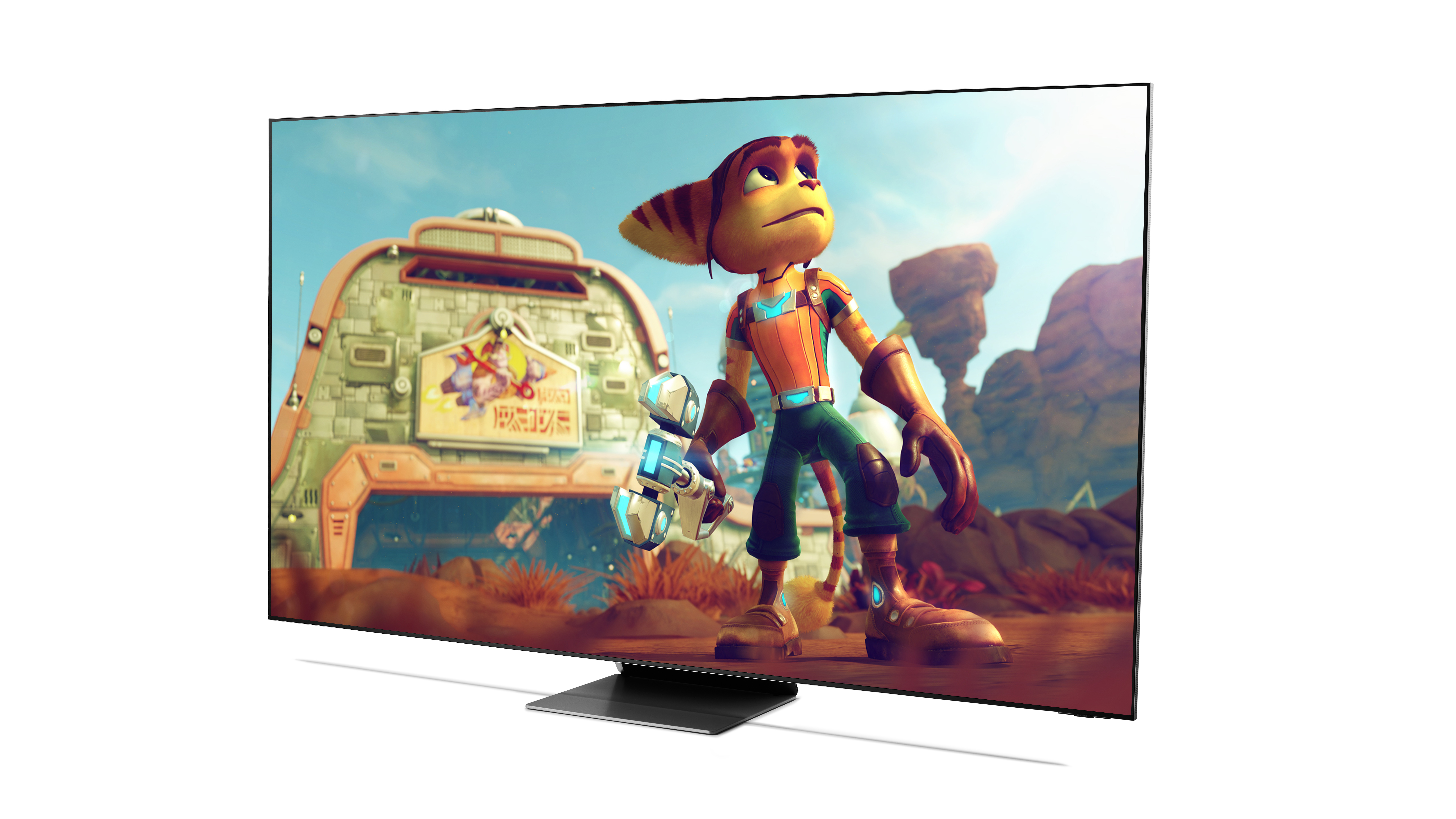
You lot certainly don't need an 8K Telly for gaming, what with there beingness no 8K games or fifty-fifty consoles out there, but the actress resolution does actually help when you get into very big screen sizes. That'south considering it increases pixel density which, when combined with excellent upscaling such as that of the QN900A, results in a sharper, crisper picture than yous go from similarly sized 4K models.
The QN900A also boasts all of Samsung'southward pinnacle gaming tech. All four of its 1 Connect box'south HDMIs are 2.1-certified, with total back up for ALLM, 4K@120Hz and VRR. There's an HGIG setting, also. A lack of Dolby Vision is the merely disappointing omission.
Samsung's also created the 'Game Bar' – a popular-up menu that gives you lot quick admission to various game-related features and delivers live data on the signal being received, including the VRR format and frame rate. Input lag is astonishingly low – low enough, in fact, that you can afford to sacrifice a few milliseconds to enable some gaming-specific motility smoothing, should you and then wish.
To meridian it all off, this is one of Samsung'south Mini LED-backlit Neo QLED models. It goes brilliantly bright and, thank you to thousands of private zones, has excellent contrast, too. If that makes it sound like a bit of a blunt musical instrument, the reverse is actually true – the QN900A is just as capable of delivering nuance and subtlety equally it is awesome punch and vibrancy. This is a truly exceptional TV that volition reward those willing to sacrifice the money and infinite.
Read the full Samsung QE75QN900A review
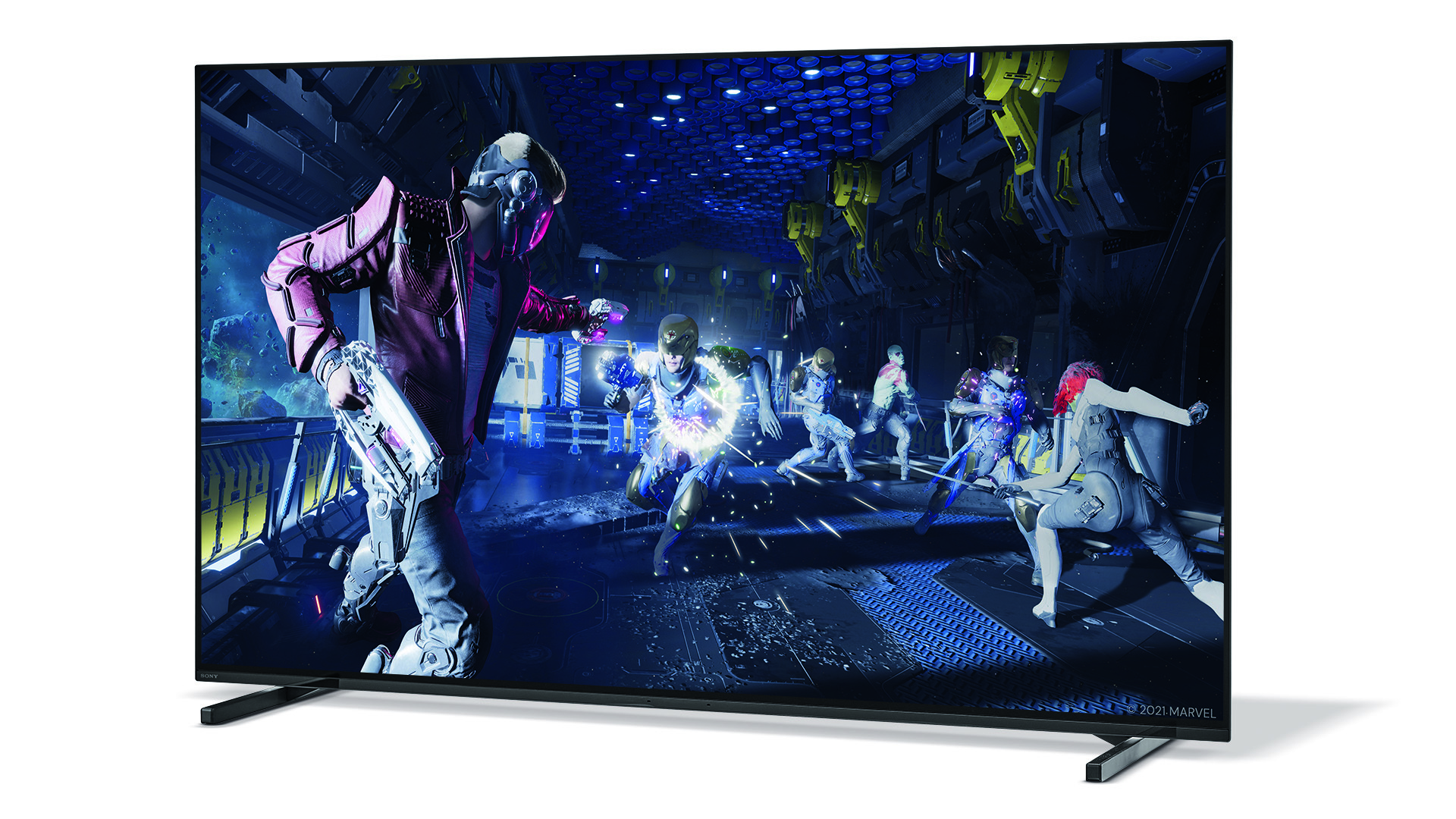
The A80J might well be the best performance-per-pound TV that Sony has ever produced, boasting nearly of the brilliance of the flagship A90J at a much lower toll. It's actually amend than the LGs and Samsungs in this list when it comes to watching movies and Idiot box shows, and only ends upward below them in this list because it'southward slightly behind in terms of next-gen gaming specs.
The good news is that the A80J does have HDMI 2.1 sockets that support 4K@120Hz, ALLM and (thanks to a firmware update delivered in early 2022) VRR, but in that location are just two of them and ane of them also handles eARC/ARC, potentially limiting you to connecting just 1 HDMI 2.ane source if you need to use the other for your audio system.
HGiG is missing, also, and at that place's no Dolby Vision game style despite the set up supporting Dolby Vision for movies and Idiot box shows. Y'all can still game in Dolby Vision if you wish, but input lag will be very high.
Finally, while the A80J's 4K@120Hz feature works fine with a PS5, during testing it caused issues with an Xbox Series 10 if Dolby Atmos sound was as well enabled. With an LG OLED, yous don't take any of these limitations or foibles – everything simply works.
Plenty of caveats, then, but none that should be of business concern to PS5 gamers, and the A80J's superb moving picture and sound functioning translates very well indeed to 4K and HD games.
Read the full Sony XR-55A80J review
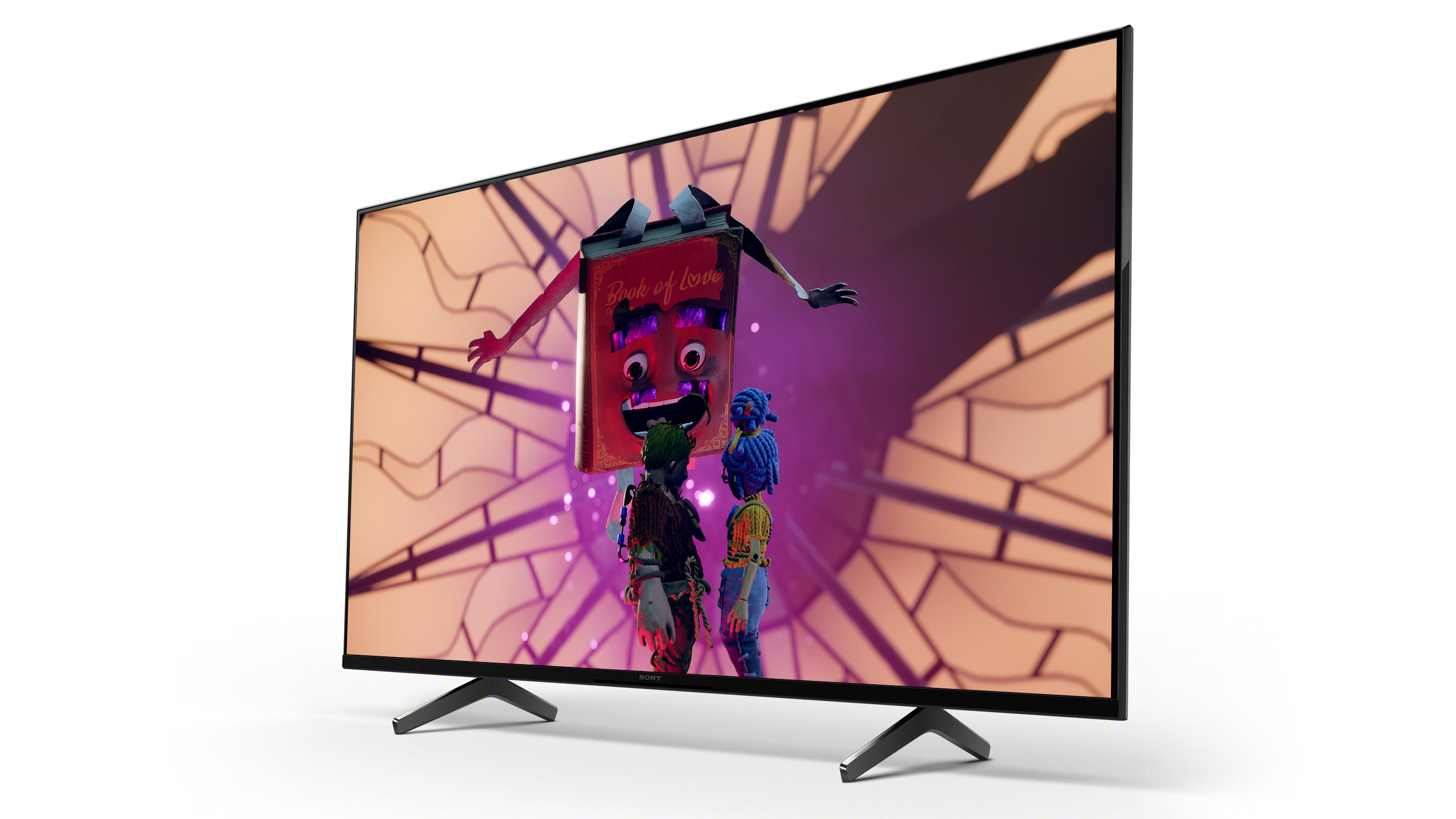
The X90J's pictures aren't exactly shy and retiring – and that's fine past united states. Exceptional amounts of brightness make it onto the screen with startling consistency, delivering some of the virtually apartment-out punchy and bright HDR pictures we've ever seen on a fifty-inch Idiot box.
It's not merely brightness for brightness sake, either. Sony is unashamedly using it to evangelize as uncompromising an HDR experience equally information technology can within its backlight limitations. And then daylight HDR scenes expect more natural and realistically brilliant by far than they practice on any other current Television set in its size and class.
Even more impressively, the XR-50X90J has enough headroom with its brightness to ensure that the brightest highlights of already vivid HDR images enjoy that actress stride up in intensity that ordinarily just the most premium TVs provide.
The price you pay for this superb effulgence is slightly elevated blackness levels and occasional backlight blooming, but neither upshot is a huge deal-breaker, and yous tin can also add excellent motion processing, natural colours and decently dynamic sound to the listing of the Sony's strong points.
It's besides got ii HDMI two.1 ports that support 4K at 120Hz, ALLM and (since early 2022) VRR, making it a skillful option for next-gen gamers. There'due south no HGiG support or Dolby Vision game mode, only that won't be of concern to PS5 gamers.
Equally well equally the 50-inch model, we've also tested the X90J at 65 inches, and that'south a very solid gaming Tv, as well. You can read the full reviews of both models by clicking below.
Read the total Sony XR-50X90J review
Read the full Sony XR-65X90J review
How nosotros test
How nosotros test gaming TVs
To put information technology evidently, manufacturers aren't e'er equally honest or forthcoming about gaming specs as they might be, so we ensure that nosotros test every TV to discover out whether it supports the next-gen specs nosotros're looking for and whether information technology does and then properly and finer. Nosotros also measure out input lag ourselves and don't only reprint the figure given past the manufacturer.
Simply specs but tell one-half the story, so we likewise test each Goggle box's real-life operation with a number of games from a number of genres, on both the Xbox Serial X and the PS5. Here, we're not only making sure that the Television lives upwards to its spec sheet, but as well that it delivers the core film quality we're looking for, from sharpness to responsiveness, contrast to color vibrancy.
We're besides testing the sound here: while nearly gamers will (and should) connect their TV to a dedicated audio arrangement (such as a soundbar) or their console to a gaming headset, at that place are those who volition rely on the in-built speakers, so we need to ensure those deliver a clear, spacious and engaging sound.
All of our testing is comparative, so every gaming Tv is compared side-past-side with the best gaming Tv at its size and cost, and every examination nosotros bear is collaborative, so no one member of the What Hi-Fi? team rates a product in isolation. The end outcome is a completely unbiased, exhaustively thorough review.
How to choose the best gaming Telly
Of import gaming TV features to look out for
Broadly speaking, a Idiot box that'due south peachy for TV and movies should also be great for games but, if you're looking for the very best Television receiver for gaming, at that place are a few gaming-specific features to look out for, particularly if you lot've got or are planning to get a PS5 or Xbox Series X.
The large ane is input lag, which tells yous how long your gamepad button presses volition have to appear as onscreen actions. Lower is better, only anything beneath 40ms will be imperceptible to almost all gamers, and 20ms or less is lightning-fast.
In that location are at present a number of next-gen gaming features to look out for, as well – Variable Refresh Rate (VRR), Machine Low Latency Manner (ALLM) and 4K@120Hz are all part of the HDMI 2.ane spec, only are as well available via plenty of TVs with HDMIs that are certified every bit 2.0.
VRR matches the TV's refresh rate to the frame rate being output by the panel in real-time, resulting in a smoother, faster gaming experience. The Xbox Series X, Series S, One Ten and One S (and certain PCs) tin all output VRR, and it's due to exist added to the PS5 after this year.
ALLM is simpler: information technology just means that your Goggle box volition automatically switch to its 'game fashion' to reduce input lag when it senses a game signal from your games console. Information technology's also intelligent plenty to switch game fashion off again if y'all play a motion picture or TV testify via your console, using the Netflix app, for example. This is a feature of both the Xbox Series X and the PS5.
4K/120Hz has suddenly become a big deal, too, as both the PS5 and Xbox Serial Ten back up it. Put simply, this allows a TV to handle 4K games at frame rates of upwards to 120fps. There aren't that many TVs around that tin can practice this (almost are limited to 60Hz), particularly below 55 inches, only there are some and you can expect the number to grow significantly in 2022.
Microsoft has recently upped the ante further by introducing Dolby Vision gaming, right up to 4K/120Hz. Nearly TVs that support Dolby Vision for movies and Boob tube shows should support gaming in Dolby Vision, simply very few volition exercise so at 4K/120Hz and some (including Sony) lack a dedicated Dolby Vision Game manner, and that can take a big impact on input lag. With those TVs you lot're all-time off sticking with standard HDR rather than the more than avant-garde Dolby Vision format.
On the subject of HDR, information technology's besides now worth looking out for HGiG. Rather than a fixed standard or certification, HGiG (which stands for HDR Gaming Involvement Group) is a consortium of companies that take come together in guild to create guidelines and best practices for the implementation of HDR in gaming. Console-makers Microsoft and Sony instigated the cosmos of HGiG, and members include TV manufacturers such as LG, Samsung and Panasonic, and game developers and publishers such as Activision, EA, Rockstar and Ubisoft.
Put just, the aim of HGiG is that each game is tailored to the specific capabilities of your Television set without the need for endless calibration screens. Samsung, LG and Philips have added HGiG settings to their peak sets, and they generally upshot in a more than accurate HDR moving picture with deeper blacks and more detailed highlights.
General qualities that translate well for gaming
Those specific gaming features are all well and expert, but focusing on specs solitary really isn't wise: your new Telly besides needs a broad range of core skills. For example, it needs to have the dial and vibrancy to do justice to brighter, flashier games such as Astro'due south Playroom, merely also a natural residue that doesn't oversaturate tonally subtler blockbusters such as Elden Ring.
Black depth is important for delivering drama, too, but you want to be able to encounter plenty of detail in shadows, so avert a TV with a reputation for crushing dark detail and exist certain to tweak the brightness/gamma setting for your game – about titles have a specific choice for this.
HDR is a must, of course, as the PS4, PS5, Xbox One X, One S, Series S and Serial 10 all output HDR, and you might want to look for one that supports Dolby Vision besides as standard HDR10 if you're an Xbox Series 10 possessor. More obviously, it would exist a mistake not to go a 4K screen, even if you lot don't all the same take a 4K panel. The proficient news is that it's now pretty hard to buy a Television set that doesn't have 4K and at least HDR10.
8K vs 4K@120Hz

Merely what about 8K? Both the PS5 and Xbox Series Ten can handle 8K in theory, just neither has the feature enabled at this point.
It seems that the focus is on higher frame rates in the short term, with higher resolutions potentially coming after. Fifty-fifty then, native 8K gaming seems unlikely. Information technology'southward broadly agreed that neither console has the processing power to run blockbuster games at that resolution. Nosotros might, though, see games appear that dynamically scale at resolutions above 4K earlier existence output every bit an 8K bespeak, much every bit the PS4 Pro and Xbox One X invariably handled 4K on games (truly native 4K games were very rare until this new console generation, and i might argue that they're still a myth).
In other words, while 8K should perhaps be at the back of your heed, information technology'southward certainly non essential that you buy an 8K TV correct now. Such sets will likely exist much, much more affordable by the time 8K gaming becomes a serious business – assuming it ever does. That said, there is an fantabulous 8K Goggle box on this listing for those who have very deep pockets.
- Looking for more of an all-rounder? These are the best TVs currently available
- Here are the All-time inexpensive TVs for those on a tight budget
- If you're even so torn on which panel to buy, check out our PS5 vs Xbox Series X shootout
Best Budget 4k Tv for Xbox One X
Posted by: phillipdrowed.blogspot.com